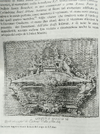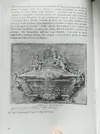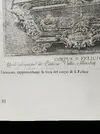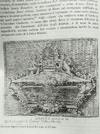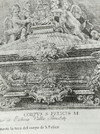Inside the church of Valle Benedetta there is a small temple similar to the one in Jerusalem that covers the Holy Sepulcher. The Valle Benedetta Sepolcro is identical to that of Jerusalem, both in its size and its features. Many people ask why Don Colombino Bassi and Antonio Huygens wanted to reproduce a tomb similar to that of Jerusalem. This question was also posed by a Camaldolese friar, Don Isidoro, who in 1783, as soon as he took over the Church of the Valle Benedetta, wanted to check in person what was under the Tablerial floor of the Sepulcher. The friar removed the floor very easily and brought to light an almost intact corpse. Shocked by the incident, he immediately informed the ecclesiastical authorities that sent Father Eustachio, who ordered to bury the body even lower so that no one could find it again. Friar Isidoro was removed from the church for digging without authorization. Years later he was recalled to the head of the church with the assurance of not divulging the news. The secret remained so until 1806 when Don Isidoro wanted to confide the secret to two of his brother friars Don Mansueto and Don Damiano Magni who succeeded him as head of the church. These two friars became aware of another important relic, hidden in the church.
It was the sacred mantle of San Francesco da Paola. This cloak had the power to resurrect the dead, in fact San Francesco da Paola used it to revive a condemned man to death. This cloak could still be in the Valle Benedetta, certainly there was until 1875 when a priest called Michele Pistucci had the audacity to wear it. We do not know what happened to the priest nor the mantle ...
A necessary clarification, the mantle of San Francesco da Paola was donated to Colombino Bassi by the Grand Duchess Vittoria della Rovere together with the relic of the "whole body" of San Felice. This cloak attracted the attention of the noble Huygens as he wanted to use the powers of the cloak for personal purposes. The coat could not be used by ordinary people, but only by true saints. This is why Huygens had to renounce eternal life. Huygens later found the solution in the Romitone mirror. Here another clarification is needed to explain how Huygens came into possession of the mirror of the Romitone: in 1707 the noble Huygens had a beautiful villa built in the locality "meadows of Saint Lucia". During the excavations the remains of an ancient abbey came to light in which the black hermits hid the mirror of the Romitone that the Templars called "the throne of the Jews". In addition to the mirror of the Romitone Huygens found numerous manuscripts that narrated the history of the mirror and its use. Huygens did not warn Don Colombino Bassi of the discovery and wanted to keep this secret for himself in anticipation of his personal use: obtaining eternal life. Which partly succeeded, but this is a story that has not yet been completed.
Who will find the sacellum of Huygens will give peace to his soul and tear him from the clutches of the Romitone... Moreover who will have the courage to find the sacellum of Huygens will become very rich because the sacellum is completely made of gold, covered with a strange green paint fluorescent. Carla, sister of Don Primo, confided to Leale Martelli that her brother, Don Primo, had discovered a tunnel that started from the crypt of San Felice and reached the stone garden of Villa Huygens. The captain told Carla he had found the sacellum, but did not know it was gold. When the captain returned to the stone garden to find the sacellum, he realized that it had been picked up. Carla suspected that her brother had moved it to hide it in a deeper part of the tunnel, where it is thought to be still...

